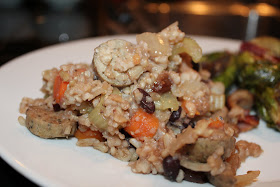Fall is the season of squash, and I'm always looking for an excuse to cook with it. Spaghetti squash is especially fun because it has a pasta-like texture and offers a healthy - and gluten-free - substitution that's nutrient-packed and tasty. It is also great for kids because it has a fun yet mild consistency that will help boost their vegetable quota for the day.
This recipe was inspired by a post from Big Girl Small Kitchen sent to me by my best friend. I expanded upon it by adding homemade grass-fed beef meatballs and sauteed mushrooms, and I modified the process. You can also use turkey meatballs or add a vegetarian protein source using canellini beans. My husband really liked it and said that he didn't miss the pasta!
In honor of Halloween and this year's nutrition-inspired costume, here's a shot of me as "grass-fed beef":

By the way, to make the meatballs I use a recipe I made up myself:
3 lb grassfed beef (I get mine at the North Scottsdale Farmers Market)
Homemade breadcrumbs (sprinkle olive oil over Ezekiel or other whole grain or gluten-free bread and add garlic powder; toast in a toaster oven until dark and pulse in a food processor to make crumbs)
1 organic egg
1/2 cup raw parmesan shavings
Garlic powder
1 bunch fresh parsley, chopped
Sea salt and pepper
Combine all ingredients and roll into 1-inch balls. Bake on a baking sheet at 350 degrees for 12-15 minutes or until lightly browned. This recipe made about 50 meatballs, and I froze most of them for a future recipe.
Spaghetti Squash, Ricotta and Meatball Bake
Ingredients:
1 spaghetti squash (4-5 lb)
2 teaspoons olive oil
12 ounces mushrooms, sliced
1 cup organic marinara sauce, divided
3/4 cup ricotta cheese, divided
Grass-fed beef meatballs (12-15)
3/4 cup grated parmesan cheese
Instructions:
Rinse the squash and cut in half length-wise.


Use an ice cream scooper to remove and discard the seeds.

Sprinkle with salt and pepper and place on a baking sheet, flesh-side down.

Bake at 375 degrees for about 45 minutes, or until the skins have darkened on the edges.

While the squash is baking, heat olive oil in a pan and add garlic. Sautee the mushrooms until cooked through.

When the squash has finished baking, remove from the oven and let cool for 15-20 minutes. (Seriously, how pretty and delicious does this look?! I wanted to eat it plain, right then and there.)

Use a fork to scrape the flesh into a bowl.




Set into a strainer to remove some of the liquid.

Using a clean paper towel, squeeze the squash to remove as much liquid as you can. Nobody wants a soggy meal.

Place the squash in a mixing bowl and add 1/2 cups marinara sauce and 1/2 cup ricotta. (This is where you can play with spices too, such as oregano, additional garlic, or even a little rosemary.)


Pour the mixture into a 9x9 baking dish. Layer with meatballs, and then top with mushrooms and the other half of the marinara sauce.



Sprinkle with parmesan cheese and small dabs of ricotta.

Bake for 35-40 minutes at 375, or until the top is browned.

Enjoy with some roasted vegetables or a crisp green salad and a nice glass of cabernet! This recipe made about 6 servings.

Enjoy!
*M*






















